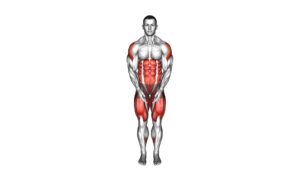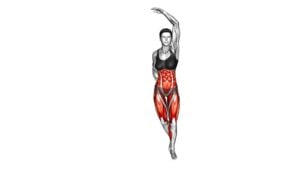Rear Fly Stepback (female) – Video Exercise Guide & Tips

Get ready to tone your back and improve your posture with the Rear Fly Stepback exercise.
Watch This Exercise Video
In this video guide, we'll show you the proper form, variations, and modifications for maximum results.
Avoid common mistakes and get expert tips on how to incorporate this exercise into your workout routine.
Whether you're a beginner or a seasoned fitness enthusiast, this exercise will help you achieve a stronger, more sculpted back.
Let's get started!
Key Takeaways
- Rear Fly Stepback improves upper body strength and posture.
- It targets and strengthens the upper back muscles, including the rhomboids and rear deltoids.
- It reduces the risk of back pain and injuries.
- Rear Fly Stepback engages the core and leg muscles, improving overall body alignment and stability.
Benefits of the Rear Fly Stepback
You can experience improved upper body strength and posture by incorporating the Rear Fly Stepback into your exercise routine. This exercise specifically targets the upper back muscles, helping to strengthen and tone them. By focusing on these muscles, you can improve your posture, which is essential for overall body alignment and reducing the risk of back pain and injuries.
The Rear Fly Stepback involves standing with your feet shoulder-width apart and holding a pair of dumbbells in each hand. Step one foot back into a lunge position while simultaneously lifting your arms out to the sides, squeezing your shoulder blades together. Return to the starting position and repeat on the other side.
By performing the Rear Fly Stepback regularly, you can strengthen the muscles in your upper back, including the rhomboids, trapezius, and posterior deltoids. This increased strength helps to pull your shoulders back and improves your posture by counteracting the effects of hunching over a desk or slouching.
Incorporate the Rear Fly Stepback into your exercise routine to target your upper back muscles and improve your overall posture. Remember to start with lighter weights and gradually increase the resistance as you get stronger. Be mindful of your form and engage your core muscles for stability. With consistency and proper technique, you'll see improvements in your upper body strength and posture.
Proper Form for the Rear Fly Stepback
To ensure proper form for the Rear Fly Stepback, focus on maintaining a stable core and keeping your shoulders engaged throughout the exercise. This will help you maximize the benefits and minimize the risk of injury. Here are some key tips to follow:
- Stepback technique: Start by standing with your feet shoulder-width apart and holding dumbbells in each hand. Take a step back with your left foot, keeping your right leg stable. As you step back, hinge forward at the hips and lift your left leg behind you. Simultaneously, raise your arms out to the sides, squeezing your shoulder blades together. Return to the starting position and repeat on the other side.
- Engage your core: Throughout the exercise, focus on keeping your core muscles engaged to maintain stability. This will help protect your lower back and improve your overall form.
- Shoulder engagement: As you raise your arms out to the sides, imagine squeezing a pencil between your shoulder blades. This will ensure that you're targeting the rear deltoids, upper back, and shoulder muscles effectively.
- Controlled movement: Avoid swinging your arms or using momentum to complete the exercise. Instead, focus on controlled, deliberate movements to really engage the targeted muscles.
Variations and Modifications for the Rear Fly Stepback
For variations and modifications of the Rear Fly Stepback, try incorporating different types of resistance or adjusting the range of motion. By doing so, you can target different muscle groups and add variety to your workout routine.
One alternative to the traditional dumbbell Rear Fly Stepback is to use resistance bands. These bands provide a different type of resistance and can help to strengthen your muscles in a different way. To perform the exercise with resistance bands, simply attach the band to a stable anchor point and hold the handles in your hands. Step back into a lunge position and then perform the rear fly motion by squeezing your shoulder blades together.
Another equipment option to consider is using kettlebells instead of dumbbells. Kettlebells add an extra challenge to the exercise due to their unique shape and weight distribution. Hold the kettlebells in each hand and perform the Rear Fly Stepback as usual. The added challenge of the kettlebells will engage your core and stabilizer muscles even more.
Common Mistakes to Avoid With the Rear Fly Stepback
A common mistake to avoid with the Rear Fly Stepback is rushing through the exercise without maintaining proper form and control. This can lead to ineffective results and potential injury. To ensure you're performing the exercise correctly, here are some common mistakes to avoid and tips for proper technique:
- Using momentum: Avoid swinging your arms or using your body's momentum to complete the movement. This takes away from targeting the intended muscles and reduces the effectiveness of the exercise.
- Lifting too heavy: It's important to choose an appropriate weight that allows you to maintain proper form throughout the exercise. Lifting too heavy can compromise your form and increase the risk of injury.
- Neglecting core engagement: Remember to engage your core muscles throughout the movement to provide stability and support for your back.
- Not squeezing the shoulder blades: At the top of the movement, focus on squeezing your shoulder blades together to fully engage the muscles of your upper back.
Tips for Incorporating the Rear Fly Stepback Into Your Workout Routine
When incorporating the Rear Fly Stepback into your workout routine, it's important to prioritize proper form and control to maximize its effectiveness. This exercise is a great way to combine effective cardio exercises with upper body strength training. To ensure you get the most out of this move, follow these tips.
First, start with light weights and gradually increase the resistance as you get stronger. This will help prevent injury and allow you to maintain proper form throughout the exercise. Remember to engage your core and keep your back straight as you perform the movement.
Second, focus on squeezing your shoulder blades together as you move your arms back. This will activate the muscles in your upper back, helping to improve posture and strengthen your upper body.
Additionally, keep a steady pace and strive for controlled movements. Avoid using momentum to swing the weights, as this can diminish the effectiveness of the exercise. Instead, focus on the contraction and extension of your muscles with each repetition.
Finally, incorporate the Rear Fly Stepback into your workout routine 2-3 times per week, alternating with other upper body exercises for a well-rounded strength training program.
Frequently Asked Questions
How Many Calories Does the Rear Fly Stepback Burn?
The rear fly stepback is an effective exercise that can help you burn calories. It targets your back muscles and can be modified to suit your fitness level. By incorporating this exercise into your workout routine, you can improve your posture, strengthen your upper body, and increase your overall calorie burn.
It's a great way to add variety to your workouts and challenge yourself.
Can the Rear Fly Stepback Help Improve Posture?
The rear fly stepback can definitely help improve your posture. By targeting the muscles in your upper back and shoulders, it strengthens them, leading to better alignment and posture.
Additionally, this exercise also provides overall strength benefits, as it engages your core and lower body muscles.
To modify the rear fly stepback for different fitness levels, you can adjust the weight or resistance used, or even start with bodyweight exercises before progressing to using weights.
Is the Rear Fly Stepback Suitable for Beginners?
Yes, the rear fly stepback is suitable for beginners. There are variations of the exercise that are specifically designed for beginners, allowing them to build strength and improve their posture gradually.
Additionally, there are modifications for the rear fly stepback for those with limited mobility. These modifications can help individuals with physical limitations still benefit from the exercise.
Can the Rear Fly Stepback Be Done Without Weights?
The rear fly stepback can definitely be done without weights. This exercise is great for improving upper body strength. By engaging your back muscles, shoulders, and arms, you'll see benefits like increased muscle tone and improved posture.
If you're looking for an added challenge, you can try variations of the rear fly stepback, like using resistance bands or kettlebells. These variations will give you an extra burn and help you build even more strength.
How Often Should the Rear Fly Stepback Be Performed for Optimal Results?
For optimal results, it's important to consider the frequency of the rear fly stepback. By incorporating variations of this exercise into your routine, you can challenge your muscles in different ways and prevent plateauing.
However, the exact frequency will depend on factors such as your fitness level and overall goals. It's generally recommended to perform the rear fly stepback 2-3 times per week, allowing for adequate rest and recovery between sessions.
Conclusion
Incorporating the rear fly stepback into your workout routine can offer numerous benefits, including improved upper body strength and posture. By maintaining proper form and avoiding common mistakes, you can maximize the effectiveness of this exercise.
Additionally, consider trying variations and modifications to keep your routine challenging and engaging. Remember to consult with a fitness professional before starting any new exercise program.
Start incorporating the rear fly stepback into your workouts and start reaping the rewards for your hard work.

Author
Years ago, the spark of my life’s passion ignited in my mind the moment I stepped into the local gym for the first time. The inaugural bead of perspiration, the initial endeavor, the very first surge of endorphins, and a sense of pride that washed over me post-workout marked the beginning of my deep-seated interest in strength sports, fitness, and sports nutrition. This very curiosity blossomed rapidly into a profound fascination, propelling me to earn a Master’s degree in Physical Education from the Academy of Physical Education in Krakow, followed by a Sports Manager diploma from the Jagiellonian University. My journey of growth led me to gain more specialized qualifications, such as being a certified personal trainer with a focus on sports dietetics, a lifeguard, and an instructor for wellness and corrective gymnastics. Theoretical knowledge paired seamlessly with practical experience, reinforcing my belief that the transformation of individuals under my guidance was also a reflection of my personal growth. This belief holds true even today. Each day, I strive to push the boundaries and explore new realms. These realms gently elevate me to greater heights. The unique combination of passion for my field and the continuous quest for growth fuels my drive to break new ground.



